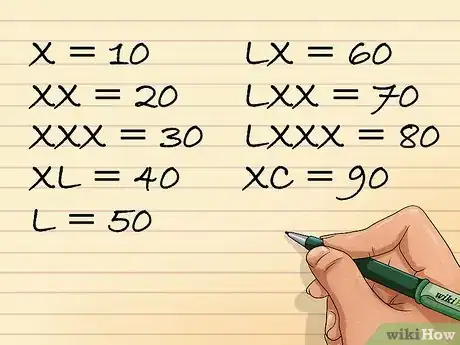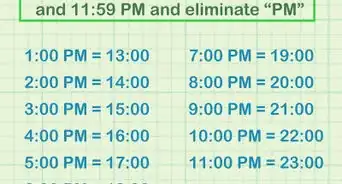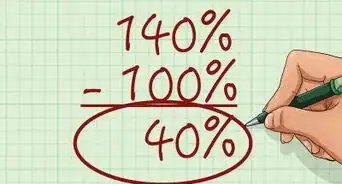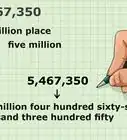wikiHow is a “wiki,” similar to Wikipedia, which means that many of our articles are co-written by multiple authors. To create this article, 44 people, some anonymous, worked to edit and improve it over time.
This article has been viewed 346,718 times.
Learn more...
Roman numerals are the numerical system used in ancient Rome. They use combinations of letters from the Latin alphabet to represent different values. Learning Roman numerals can help you write outlines, understand ancient Roman culture, and become a more cultured human being. Find out how to quickly master those tricky symbols after the jump.
Steps
-
1Understand the basic symbols. Here's what you need to know to get started:[1]
- I = 1
- V = 5
- X = 10
- L = 50
- C = 100
- D = 500
- M = 1000
-
2Use a mnemonic to memorize the value order of the symbols. If you have a hard time remembering what goes where, just try this simple one: My Dear Cat Loves Xtra Vitamins Intensely.[2]Advertisement
-
3Learn all of the digits in the ones place. Here they are:[3]
- I = 1
- II = 2
- III = 3
- IV = 4
- V = 5
- VI = 6
- VII = 7
- VIII = 8
- IX = 9
-
4Learn all of the digits in the tens place. Here they are:[4]
- X = 10
- XX = 20
- XXX = 30
- XL = 40
- L = 50
- LX = 60
- LXX = 70
- LXXX = 80
- XC = 90
-
5Learn all of the digits in the hundreds place. Here they are:[5]
- C = 100
- CC = 200
- CCC = 300
- CD = 400
- D = 500
- DC = 600
- DCC = 700
- DCCC = 800
- CM = 900
-
6Know that you can't have more than three of the same symbol in a row. When you place the same symbols together, you can just add their values. Normally the maximum number of the consecutive same symbols is three.[6]
- II = 2
- XXX = 30
-
7Add smaller symbol values that are placed after large symbol values. Similar to the above rule, just add their values together. Remember the numeral must have the larger symbol value first for this to work. Here's how you do it:[7]
- XI = 11
- MCL = 1150
-
8Subtract smaller symbol values that are placed before larger symbol values. In this case, you need to subtract the smaller value from the larger value. Here's how you do it:[8]
- IV = 4
- CM = 900
-
9Know how compound numbers are written. There are numerous rules that govern the way Roman numerals are supposed to look. Here are some rules to know:[9]
- IV should be used rather than IIII
- 2987 is written as MMCMLXXXVII because:
- The first M gives you 1000
- The next M gives you 1000
- The next CM gives you 900
- The next LXXX gives you 80
- The next VII gives you 7
- Therefore if you add the amounts together, you will get 2987.
-
10Learn to write larger numbers. Since M = 1,000, if you want to represent one million, a bar, or line, is added above the numeral M, equaling one million. The bar above the numeral represents that figure times one thousand. Thus, M x M= 1,000,000.
- Five million would be represented by MMMMM with a bar above each M. This procedure is necessary because in Roman numerals, there is no larger symbol than M (1,000). This method isn't commonly used, but it's good to know how it works.
-
11Check your work. If you want to make sure you converted a number correctly, check out some online converters to see if you're on track.[10]
Community Q&A
-
QuestionHow do I write 1,000,000?
 DonaganTop AnswererAs shown above, use M with a bar (horizontal line) above it. That means 1,000 multiplied by 1,000. Another way is to write M x M.
DonaganTop AnswererAs shown above, use M with a bar (horizontal line) above it. That means 1,000 multiplied by 1,000. Another way is to write M x M. -
QuestionHow can I learn these in a day?
 Community Answer1) Memorize the meaning of the letters (e.g. M = 1000, C =100). 2) Learn to group the combinations in different digits (E.g. Thousandth, hundereded, tenth, ones; MMCMLXXVII = MM CM LXXX VII). 3) learn when to add and when to subtract. MMCMLXXVII = (1000+1000)+(1000-100)+(50+10+10+10)+(5+1+1) = 2987
Community Answer1) Memorize the meaning of the letters (e.g. M = 1000, C =100). 2) Learn to group the combinations in different digits (E.g. Thousandth, hundereded, tenth, ones; MMCMLXXVII = MM CM LXXX VII). 3) learn when to add and when to subtract. MMCMLXXVII = (1000+1000)+(1000-100)+(50+10+10+10)+(5+1+1) = 2987 -
QuestionHow do I remember roman numerals?
 DonaganTop AnswererUse flash cards, or read this article (or others like it) over and over again until it's committed to memory. There are no shortcuts. You just have to memorize.
DonaganTop AnswererUse flash cards, or read this article (or others like it) over and over again until it's committed to memory. There are no shortcuts. You just have to memorize.
References
- ↑ http://www.mathsisfun.com/roman-numerals.html#convert
- ↑ https://www.romannumerals.org/blog/easy-ways-to-remember-roman-numerals-17
- ↑ https://www.uncp.edu/sites/default/files/2017-11/BasicCalculationsReview.pdf
- ↑ https://www.uncp.edu/sites/default/files/2017-11/BasicCalculationsReview.pdf
- ↑ https://www.uncp.edu/sites/default/files/2017-11/BasicCalculationsReview.pdf
- ↑ https://reference.yourdictionary.com/resources/romanums.html
- ↑ https://www.cuemath.com/numbers/xi-roman-numerals/
- ↑ https://mathworld.wolfram.com/RomanNumerals.html
- ↑ https://mathworld.wolfram.com/RomanNumerals.html
About This Article
To learn Roman numerals, know that I = 1, V = 5, X = 10, L = 50, C = 100, D = 500, and M = 1,000. If a symbol comes after another symbol, then you add it to the symbol before it. For example, VI = 6 since V = 5 and I = 1. If a symbol comes before another symbol, subtract it instead. For example, IV = 4. Also, keep in mind that you can't have more than 3 of the same symbol in a row. So, instead of writing VIIII for 9, you'd write IX. To learn how to write the date using Roman numerals, scroll down!





































































